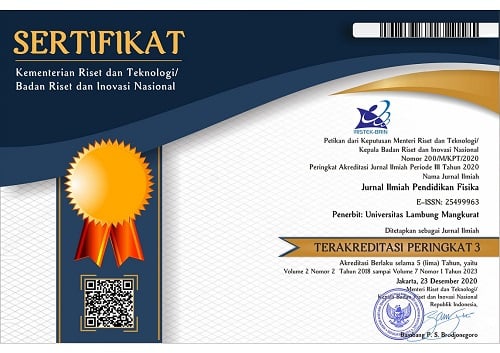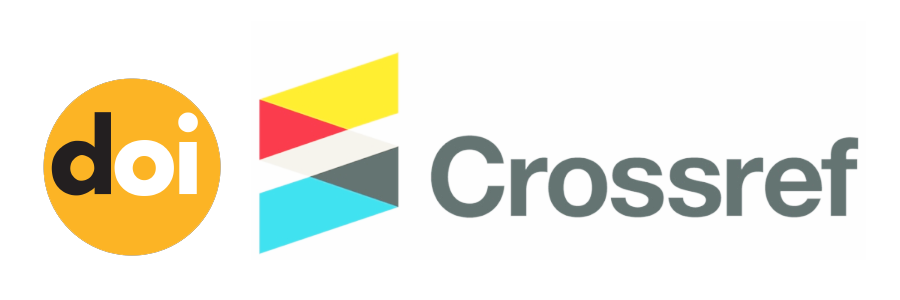Improving Students' Problem-Solving Skills Using Direct Instruction-Oriented Worksheets on the Subject of Temperature and Heat
Abstract
Problem-solving skills are among the key competencies in 21st-century life, yet they are poorly trained in schools. This study aims to produce a direct teaching-oriented temperature and heat worksheet that is feasible to use to improve students' problem-solving skills. The ADDIE design was used in the development of this worksheet. The worksheet was tested on 25 students in Class XI SMA. Data was measured using validation instruments, response questionnaires, and problem-solving tests. The results showed that the developed student worksheet was categorized as very valid, the student's response to using the worksheet was categorized as practical, and the student worksheet was categorized as effective because the N-Gain of problem-solving of 0.56 was categorized as moderate. This means that the developed direct teaching-oriented student worksheet is feasible to improve problem-solving skills. This student worksheet can be an alternative for teachers to equip 21st-century competencies, especially problem-solving skills.
Keywords
Full Text:
PDFReferences
Akbar, S. (2016). Instrumen perangkat pembelajaran. Remaja Rosdakarya.
Alsarayreh, R. S. (2023). The effect of technological skills on developing problem solving skills: the moderating role of academic achievement. International Journal of Instruction, 16(2), 40-49.
Arkunto, S. (2015). Dasar-dasar evaluasi pendidikan edisi 2. PT Bumi Aksara.
Asfar, A. M., & Nur, S. (2018). Model pembelajaran problem posing dan solving: Meningkatkan kemampuan pemecahan masalah. CV. Jejak.
Assem, H. D., Nartey, L., Appiah, E., & Aidoo, J. K. (2023). A review of student’s academic performance in physics: attitude, instructional methods, misconceptions and teachers qualification. European Journal of Education and Pedagogy, 4(1), 84-92.
Awaliyah, G. (2015). Pengaruh kemampuan pemecahan masalah terhadap hasil belajar matematika siswa kelas V SD se-gugus Ki Hajar Dewantara Kecamatan Tegal Timur Kota Tegal. Tidak Dipublikasikan.
Burkholder, E. W., Miller, O. C., & Blackmon, L. F. (2023). Investigating the epistemology of physics students while reflecting on solutions. European Journal of Physics, 44(4), 045701.
Cashata, Z. A., Seyoum, D. G., & Gashaw, F. E. (2023). Enhancing college students' procedural knowledge of physics using blended jigsaw problem-solving instruction. International Journal of Research in Education and Science, 9(1), 148-164.
Dewitasari, A. P., & Rusmini, R. (2023). Feasibility of interactive E-student worksheet based on nature of science (nos) to train students' critical thinking skills on chemical bonding material. Jurnal Penelitian Pendidikan IPA, 9(9), 7122-7131.
Djudin, T. (2023). Transferring of mathematics knowledge into the physics learning to promote students’ problem-solving skills. International Journal of Instruction, 16(4), 231-246.
Efendi, A. (2022). Improve critical thinking skills with informatics educational games. Journal of Education Technology, 6(3), 1-12.
Fatmawati, F., Rivaldi, M., & Suhaeni, S. (2023). Development of electronic student worksheets based local potential to enhance students’ science learning outcomes. JIPI (Jurnal IPA & Pembelajaran IPA), 7(1), 56-71.
Frisilla, S., & Hardeli, H. (2022). Validity and practicality of chemical equilibrium electronic student worksheets based on guided discovery learning to increase the critical thinking ability. Jurnal Penelitian
Pendidikan IPA, 8(3), 1191-1198.
Gjerde, V., Paulsen, V. H., Holst, B., & Kolstø, S. D. (2022). Problem-solving in basic physics: Effective self-explanations based on four elements with support from retrieval practice. Physical Review Physics Education Research, 18(1), 10136.
Hake, R. (1998). Interactive engagement versus traditional methods: A six thousand-student survey of mechanics test data for introductory physics courses. American Journal of Physics, 64–74.
Hariyani, M., Herman, T., Suryadi, D., & Prabawanto, S. (2022). Exploration of student learning obstacles in solving fraction problems in elementary school. International Journal of Educational Methodology, 8(3), 505-515.
Hendrayani, A., Permana, N. D., Ilhami, A., & Syarif, M. I. (2022). The development of student live worksheets based on problem-based learning in the optical instrument chapter. IJIS Edu: Indonesian Journal of Integrated Science Education, 4(1), 75-82.
Izzati, A. U., Arifuddin, M., Suyidno, S., & Misbah, M. (2020). Pengembangan perangkat pengajaran langsung untuk melatih keterampilan pemecahan masalah peserta didik SMA. Jurnal Inovasi dan Pembelajaran Fisika, 7(2), 190–199.
Karuru, P., & Kabanga, T. (2023, September). Physics learning devices development using the PIFMI model to improve student reasoning power. In AIP Conference Proceedings (Vol. 2736, No. 1). AIP Publishing.
Marlina, L., & Wiyono, K. (2023). Analysis of physics E-student worksheet needs based on problem-based learning to improve students’ critical thinking skills. Jurnal Pendidikan Fisika dan Teknologi, 9(1), 177-184.
Maulidia, Y. R. (2019). Pengembangan student worksheet menggunakan model pembelajaran langsung (direct instruction) untuk materi teks iklan, slogan, dan poster kelas VIII. Universitas Surabaya.
Maulidiya, A., & Mercuriani, I. S. (2023). Development of problem-based learning worksheets on class XI body defense system material to improve science literacy. Jurnal Pendidikan Sains Indonesia, 11(2), 251-264.
Mukti, F., Connie, C., & Medriati, R. (2018). Pengembangan lembar kerja peserta didik (student worksheet) pembelajaran fisika untuk meningkatkan kemampuan berpikir kreatif siswa SMA Sint Carolus Kota Bengkulu. Jurnal Kumparan Fisika, 1(3), 57–63.
Parasamya, C. E., & Wahyuni, A. (2017). Upaya peningkatan hasil belajar fisika siswa melalui penerapan model pembelajaran problem-based learning (PBL). Jurnal Ilmiah Mahasiswa Pendidikan Fisika, 2(1).
Sambada, D. (2012). Peranan kreativitas siswa terhadap kemampuan memecahkan masalah fisika dalam pembelajaran kontekstual. Jurnal Penelitian Fisika dan Aplikasinya, 2(2), 37.
Santrock, J. W. (2011). Educational Psychology. McGraw-Hill.
Saiful, M. (2023). The application of the relationship between the ability to study kinematics concepts and problem solving with learning achievement in physics learning. Jurnal Penelitian Pembelajaran Fisika, 9(1), 62-70.
Serevina, V., Anjani, P., & Anggraini, D. (2022, July). The validity of learning implementation plan of independent learning in online learning using direct learning models on thermodynamics subject. In Journal of Physics: Conference Series, 2309(1), 012094. IOP Publishing
Sugiyono. (2017). Metode penelitian dan pengembangan. Penerbit Alfabeta.
Susiana, N., Yuliati, L., & Latifah, E. (2017). Analisis pembelajaran berdasarkan profil kemampuan pemecahan masalah fisika siswa kelas X SMA. Universitas Muhammadiyah Malang.
Suyidno, S., Salam, A., Arifuddin, M., Misbah, M., & Siswanto, J. (2020a). Menyiapkan peserta didik untuk masyarakat 5.0 melalui creative responsibility based learning. Jurnal Pendidikan Fisika Dan Keilmuan, 6(1), 25
Suyidno, S., Haryandi, S., Mahtari, S., Azhari, A. & Sunarti, T. (2022). Autonomy-based creative learning: Equip creativity and concern for prospective physics teachers in wetland environments. Journal of Physics: Conference Series, 2392(1), 012027. IOP Publishing.
Rony, Z. T., Lubis, F. M., Santoso, B., & Rizkyta, A. (2020). The relevance of political skills for leaders and managers in the Industrial Revolution 4.0: A case study of the Indonesian private television inustry. International Journal of Innovation, Creativity and Change, 12(1), 447-465.
Thersia, V., Arifuddin, M., & Misbah, M. (2019). Meningkatkan kemampuan pemecahan masalah melalui pendekatan somatis auditori visual intelektual (SAVI) dengan model pengajaran langsung. Berkala Ilmiah Pendidikan Fisika, 7(1), 19-28.
Trimulyono, G. (2023). The development of electronic student worksheet based on multiple intelligences on human heredity materials to increase learning outcomes for 12th grade students. Berkala Ilmiah Pendidikan Biologi, 12(2), 388-402.
Werth, A., West, C. G., & Lewandowski, H. J. (2022). Impacts on student learning, confidence, and affect in a remote, large-enrollment, course-based undergraduate research experience in physics. Physical Review Physics Education Research, 18(1), 010129.
Zubairi, Z., Nurdin, N., & Solihin, R. (2022). Islamic Education in the Industrial Revolution 4.0. Scaffolding: Jurnal Pendidikan Islam dan Multikulturalisme, 4(3), 359-371.
Zulyusri, Z., Elfira, I., Lufri, L., & Santosa, T. A. (2023). Literature study: Utilization of the PjBL model in science education to improve creativity and critical thinking skills. Jurnal Penelitian Pendidikan IPA, 9(1), 133-143.
DOI: https://doi.org/10.20527/jipf.v7i3.8988
Refbacks
- There are currently no refbacks.
Indexed by: Jurnal Ilmiah Pendidikan Fisika is licensed under a creative commons attribution-share alike 4.0 international license
Statistics Counter |
















